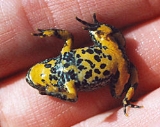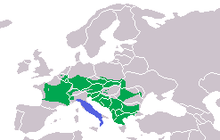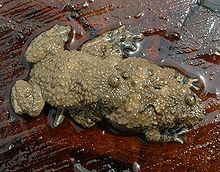
Yellow-bellied toad
Encyclopedia
The Yellow-Bellied Toad (Bombina variegata) belongs to the order
of Anura, the archaeobatrachia
l family of Bombinatoridae
, and to the genus of fire-bellied toad
s.
: The larger of the males and females are between 35 and 55 mm, making them very small for Archaeobatrachia
ns. Their top side is grey-brown, often with washed-out, bright spots. Their underside, including the inner sides of the limbs, fingers and toes is grey-blue to black-blue with striking, bright yellow to orange spots or patches, usually covering more than half of the underside. Yellow-bellied toads have a compact body - though not so flat as the related European Fire-bellied Toad
- and a rounded snout. The pupils are heart-shaped, with the eardrums not visible. The overside has numerous warts with raised swirls.
The mating call of the males can be heard in late spring and early summer, a dull but melodic "uh... uh... uh" from their mating grounds. As the species does not have a vocal bladder, in contrast to the red-bellied toad, its call is quite gentle.
Spawn
: The eggs are laid in loose clutches of 2 to 30 eggs in grass or often in patches of plants. The eggs are medium brown on the top side, bright brown on the bottom and measure on average 1.5 to 2 mm, while the jelly layer is 5 to 8 mm thick. The principal spawning time lasts from May to June.
Larva
: At their highest the edges of the fins of the 55 mm long tadpoles reach to the middle of the body; the tail ends are rounded off. They are a dirty grey in colour and shine in all colours of the rainbow.


.jpg) The yellow-bellied toad is an amphibian
The yellow-bellied toad is an amphibian
closely bound to areas of water. Originally the species typically lived along brooks and rivers. It settled there dependent on the flood dynamic of temporary and continuously shifting small bodies of water. In its replacement habitat
s in human civilisation it is still dependent on temporary small bodies of water on loamy ground, such as tractor trails, puddles and small ditches. Mostly these areas are bereft of vegetation and free of competing species and predators. Through the quick heating of small bodies of water a rapid development of spawn and larvae is guaranteed. These pioneer species can be found mainly in quarries, clay- and gravel-pits and on marching grounds.
The superior mobility of the young of the species allows spontaneous settlement of newly discovered living spaces. On land the creatures look for hiding places under stones, dead wood and in the furrows and crevices of rocks. The yellow-bellied toad dwells in mountainous and hilly countries in middle and southern Europe. It is widely spread across the high hill area of middle and southern Germany and the Upper Rhine River Plains, but in few places.
Order (biology)
In scientific classification used in biology, the order is# a taxonomic rank used in the classification of organisms. Other well-known ranks are life, domain, kingdom, phylum, class, family, genus, and species, with order fitting in between class and family...
of Anura, the archaeobatrachia
Archaeobatrachia
Archaeobatrachia is a suborder of Anura containing various primitive frogs and toads. As the name literally suggests, these are the most primitive frogs. Many of the species show certain physiological characteristics which are not present in other frogs and toads, thus giving rise to this group...
l family of Bombinatoridae
Bombinatoridae
Bombinatoridae are often referred to as Fire-bellied toads because of their brightly colored ventral sides, which show that they are highly toxic to humans. This family includes two genera, Barbourula and Bombina, both of which have flattened bodies.Bombina are warty, aquatic toads about in...
, and to the genus of fire-bellied toad
Fire-bellied toad
The Fire-bellied Toads is a group comprising eight species of small toads belonging to the genus Bombina...
s.
Anatomy
AdultAdult
An adult is a human being or living organism that is of relatively mature age, typically associated with sexual maturity and the attainment of reproductive age....
: The larger of the males and females are between 35 and 55 mm, making them very small for Archaeobatrachia
Archaeobatrachia
Archaeobatrachia is a suborder of Anura containing various primitive frogs and toads. As the name literally suggests, these are the most primitive frogs. Many of the species show certain physiological characteristics which are not present in other frogs and toads, thus giving rise to this group...
ns. Their top side is grey-brown, often with washed-out, bright spots. Their underside, including the inner sides of the limbs, fingers and toes is grey-blue to black-blue with striking, bright yellow to orange spots or patches, usually covering more than half of the underside. Yellow-bellied toads have a compact body - though not so flat as the related European Fire-bellied Toad
European Fire-bellied Toad
The European Fire-bellied Toad Bombina bombina is a fire-bellied toad native to mainland Europe. These toads are slightly toxic sometimes to humans...
- and a rounded snout. The pupils are heart-shaped, with the eardrums not visible. The overside has numerous warts with raised swirls.
The mating call of the males can be heard in late spring and early summer, a dull but melodic "uh... uh... uh" from their mating grounds. As the species does not have a vocal bladder, in contrast to the red-bellied toad, its call is quite gentle.
Spawn
Spawn (biology)
Spawn refers to the eggs and sperm released or deposited, usually into water, by aquatic animals. As a verb, spawn refers to the process of releasing the eggs and sperm, also called spawning...
: The eggs are laid in loose clutches of 2 to 30 eggs in grass or often in patches of plants. The eggs are medium brown on the top side, bright brown on the bottom and measure on average 1.5 to 2 mm, while the jelly layer is 5 to 8 mm thick. The principal spawning time lasts from May to June.
Larva
Larva
A larva is a distinct juvenile form many animals undergo before metamorphosis into adults. Animals with indirect development such as insects, amphibians, or cnidarians typically have a larval phase of their life cycle...
: At their highest the edges of the fins of the 55 mm long tadpoles reach to the middle of the body; the tail ends are rounded off. They are a dirty grey in colour and shine in all colours of the rainbow.
Distribution


.jpg)
Amphibian
Amphibians , are a class of vertebrate animals including animals such as toads, frogs, caecilians, and salamanders. They are characterized as non-amniote ectothermic tetrapods...
closely bound to areas of water. Originally the species typically lived along brooks and rivers. It settled there dependent on the flood dynamic of temporary and continuously shifting small bodies of water. In its replacement habitat
Habitat (ecology)
A habitat is an ecological or environmental area that is inhabited by a particular species of animal, plant or other type of organism...
s in human civilisation it is still dependent on temporary small bodies of water on loamy ground, such as tractor trails, puddles and small ditches. Mostly these areas are bereft of vegetation and free of competing species and predators. Through the quick heating of small bodies of water a rapid development of spawn and larvae is guaranteed. These pioneer species can be found mainly in quarries, clay- and gravel-pits and on marching grounds.
The superior mobility of the young of the species allows spontaneous settlement of newly discovered living spaces. On land the creatures look for hiding places under stones, dead wood and in the furrows and crevices of rocks. The yellow-bellied toad dwells in mountainous and hilly countries in middle and southern Europe. It is widely spread across the high hill area of middle and southern Germany and the Upper Rhine River Plains, but in few places.
Legal protection status
- Special Area of ConservationSpecial Area of ConservationA Special Area of Conservation is defined in the European Union's Habitats Directive , also known as the Directive on the Conservation of Natural Habitats and of Wild Fauna and Flora...
– Schedules 2 and 4 ("Particular protection areas designated"; "Strongly protected") - Bundesartenschutzverordnung (BArtSchV, Eng: Federal order of species protection) – Special protection

